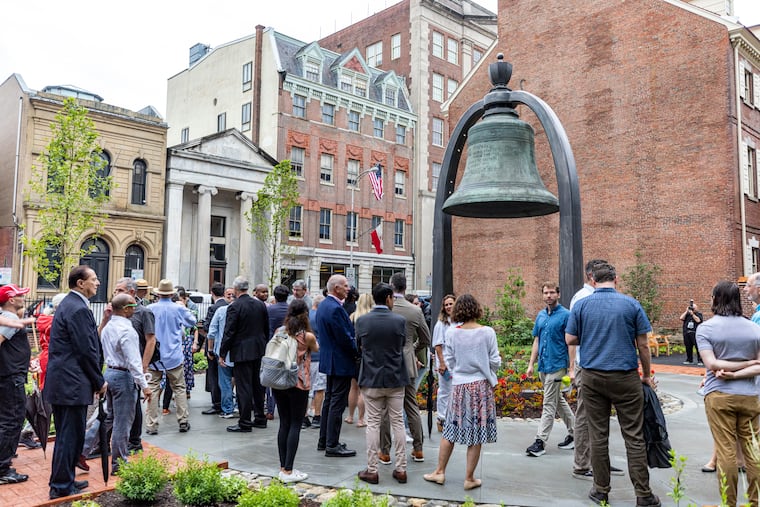The Bicentennial Bell gets a new, flower-filled home in Old City
The bell, which was a gift from Queen Elizabeth II in 1976, is now on land where one of the signers of the Declaration of Independence lived.

The Bicentennial Bell — a dead ringer for the Liberty Bell that was gifted to the United States by Queen Elizabeth II — was unveiled in its new location at the recently-renovated Benjamin Rush Garden during a ceremony in Old City Friday, more than a decade after it was last on public view.
The rain held out just long enough for officials to say a few remarks to the crowd of about 75 people and hold a ribbon cutting for the park at Walnut and Third Streets, just across from the Merchants’ Exchange Building.
“I wouldn’t be a British diplomat if I didn’t start by paying tribute to the wonderful British weather,” said British Consul General Hannah Young of New York, whose region covers Pennsylvania. “It’s great for the garden, as you say, but we’ll claim this one. You’re welcome.”
Young said the bell was “ultimately a birthday present” from Queen Elizabeth II in 1976, when she came to Philadelphia for the Bicentennial celebrations.
“The late queen noted that the words ‘Let freedom ring’ are inscribed on the bell and declared it ‘a message in which both our people can join and which I hope will be heard around the world for centuries to come,’” Young said.
“Let freedom ring,” is a line in “My Country ‘tis of Thee,” which is sung to the same tune as the British National Anthem.
The bell was cast at London’s Whitechapel Foundry, the same foundry where the Liberty Bell was originally cast (the first Liberty Bell cracked on a test ring, was melted down by John Pass and John Stow, and then recast in Philadelphia).
Made of copper and tin alloy, the Bicentennial Bell is 6-feet-10 inches in diameter, 5-feet-6 inches tall, and weighs more than 12,000 pounds, which is six times heavier than the Liberty Bell.
It originally hung in a 130-foot bell tower at the former site of the Independence National Historical Park Visitors Center at Third and Chestnut Streets, where it rang twice a day. The bell went into storage in 2013 when that building was razed to make way for the Museum of the American Revolution and it remained in storage until this year, when passersby first saw it reappear at the garden in April.
The garden, which is part of Independence National Historical Park, is on the site of the former home of Benjamin Rush, a prominent 18th century physician and one of the signers of the Declaration of Independence. Rehabilitations to the garden began in November as part of preparations for the semiquincentennial in 2026, thanks to Independence Historical Trust and a $1 million donation from the Landenberger Family Foundation.
It now includes a wheelchair ramp, several benches, a plaque of Queen Elizabeth II in profile, and another plaque of the speech she gave when she presented the bell (the latter two of which were also at the bell’s previous location).
In the center of the garden the bell hangs from a large armature with pinpoint lights on its interior, to illuminate the bell at night. The stone circle at the base is engraved with 13 interlocking rings, each containing the name of one of the 13 original colonies.
The trees and flowers that fill the garden — from smooth hydrangea to celestial dogwoods — are all plants traded between the U.K. and the American colonies in the 18th century. Upon exiting Friday’s events, guests received seed packets for some of the plants in the garden.
Susan Kettell, 81, of Old City, who saw Queen Elizabeth II during her 1976 visit to Philly, came to the ceremony with a handmade sign she hung around her neck that read: “SAVE OUR DEMOCRACY.”
Kettell has been wearing it to events around the city, not to “rabble rouse” but to remind people of what Benjamin Franklin said when he was asked if our nation would be a republic or a monarchy — “A republic, if you can keep it.”
“We got it and we’ve got to save it. That’s why I do this,” Kettell said. “We rebelled against England back then but now they’re our ally and we need them. We have to work together to save our democracy.”